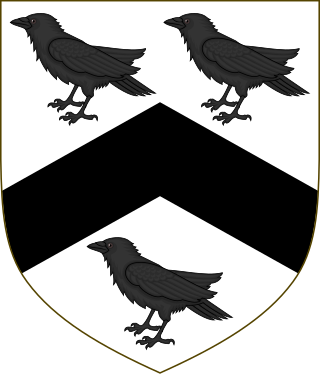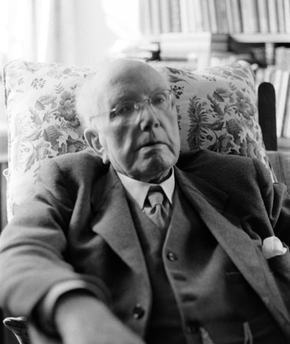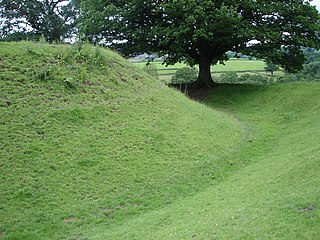
In Celtic cultures, a bard is an oral repository and professional story teller, verse-maker, music composer, oral historian and genealogist, employed by a patron to commemorate one or more of the patron's ancestors and to praise the patron's own activities.
Aneirin, also rendered as Aneurin or Neirin and Aneurin Gwawdrydd, was an early Medieval Brythonic war poet who lived during the 6th century. He is believed to have been a bard or court poet in one of the Cumbric kingdoms of the Hen Ogledd, probably that of Gododdin at Edinburgh, in modern Scotland. From the 17th century, he was usually known as Aneurin.

In Welsh culture, an eisteddfod is an institution and festival with several ranked competitions, including in poetry and music. The term eisteddfod, which is formed from the Welsh morphemes: eistedd, meaning 'sit', and fod, meaning 'be', means, according to Hywel Teifi Edwards, "sitting-together." Edwards further defines the earliest form of the eisteddfod as a competitive meeting between bards and minstrels, in which the winner was chosen by a noble or royal patron.

Edward Williams, better known by his bardic name Iolo Morganwg, was a Welsh antiquarian, poet and collector. He was seen as an expert collector of Medieval Welsh literature, but it emerged after his death that he had forged several manuscripts, notably some of the Third Series of Welsh Triads. Even so, he had a lasting impact on Welsh culture, notably in founding the secret society known as the Gorsedd, through which Iolo Morganwg successfully co-opted the 18th-century Eisteddfod revival. The philosophy he spread in his forgeries has had an enormous impact upon neo-Druidism. His bardic name is Welsh for "Iolo of Glamorgan".

Y Gododdin is a medieval Welsh poem consisting of a series of elegies to the men of the Brittonic kingdom of Gododdin and its allies who, according to the conventional interpretation, died fighting the Angles of Deira and Bernicia at a place named Catraeth in about AD 600. It is traditionally ascribed to the bard Aneirin and survives only in one manuscript, the "Book of Aneirin".
Medieval Welsh literature is the literature written in the Welsh language during the Middle Ages. This includes material starting from the 5th century AD, when Welsh was in the process of becoming distinct from Common Brittonic, and continuing to the works of the 16th century.

Urien ap Cynfarch Oer or Urien Rheged was a powerful sixth-century Brittonic-speaking figure who was possibly the ruler of the territory or kingdom known as Rheged. He is probably the best-known and certainly the best documented of the British figures of the 'Old North' in the sixth century. His kingdom was most likely centred around the Solway Firth. The most secure evidence for his existence comes from a ninth-century Welsh history and eight praise-poems in Middle Welsh dedicated to him surviving in a fourteenth-century manuscript. Despite their being found in Middle Welsh orthography, the poems may possibly reflect earlier material, even material contemporaneous to Urien. One of these poems is explicitly attributed to the famed poet Taliesin in the manuscript. The early material paints Urien as a ferocious warrior and a major political figure in his time, conquering Picts, Anglo-Saxons, and Britons of the 'Old North' alike. According to the Historia Brittonum, Urien, with three other kings confederate with him, nearly exterminated the newly-arrived Anglo-Saxons in Britain, though this campaign was brought to an abrupt end when Urien was murdered by one of his allies. In addition to this earlier material, Urien and his family feature elsewhere in medieval literature from Wales. Outside of the historical Welsh context, he eventually was transformed in Arthurian legend into the figure of king Urien of Garlot or Gorre. His most celebrated son, Owain, likewise gave his name to the Arthurian character of Ywain.
Awen is a Welsh, Cornish and Breton word for "inspiration".

Sir Ifor Williams, was a Welsh scholar who laid the foundations for the academic study of Old Welsh, particularly early Welsh poetry.
Llywarch Hen, was a prince and poet of the Brythonic kingdom of Rheged, a ruling family in the Hen Ogledd or "Old North" of Britain. Along with Taliesin, Aneirin, and Myrddin, he is held to be one of the four great bards of early Welsh poetry. Whether he actually wrote the poems attributed to him is unknown, and most of what is known about his life is derived from early medieval poems which may or may not be historically accurate.
Dafydd ab Edmwnd was one of the most prominent Welsh language poets of the Later Middle Ages.

Welsh-language literature has been produced continuously since the emergence of Welsh from Brythonic as a distinct language in around the 5th century AD. The earliest Welsh literature was poetry, which was extremely intricate in form from its earliest known examples, a tradition sustained today. Poetry was followed by the first British prose literature in the 11th century. Welsh-language literature has repeatedly played a major part in the self-assertion of Wales and its people. It continues to be held in the highest regard, as evidenced by the size and enthusiasm of the audiences attending the annual National Eisteddfod of Wales, probably the largest amateur arts festival in Europe, which crowns the literary prize winners in a dignified ceremony.
Talhaearn Tad Awen, was, according to medieval Welsh sources, a celebrated British poet of the sub-Roman period. He ranks as one of the earliest, if not the earliest, named poets to have composed and performed in Welsh. The better known poets Aneirin and Taliesin, who may have been slightly younger contemporaries, also belong to this early generation, the first of those known to modern scholars as the Cynfeirdd. Whereas medieval Welsh manuscripts preserve verse composed by or otherwise ascribed to the latter two figures, no such work survives for Talhaearn and in fact, his former fame seems to have largely vanished by the later Middle Ages.

"Owain Glyndŵr's Court", also known as "Sycharth" or "The Court of Owain Glyndŵr at Sycharth", is a cywydd by the Welsh bard Iolo Goch. It describes and celebrates the hall and household of his patron, the nobleman Owain Glyndŵr, at Sycharth in Powys. It cannot be dated exactly, but was probably written about 1390, before Glyndŵr's revolt against the English crown. It survives in as many as 24 manuscripts.
"The Ruin" is a cywydd by the 14th-century Welsh poet Dafydd ap Gwilym, widely seen as the greatest of the Welsh poets. In it the poet, considering a ruined house and remembering the love-affair he once conducted there, reflects on the transience of all worldly pleasures. "The Ruin" is commonly supposed to have been written in Dafydd's old age. It has been called one of his most poignant poems, and it was included in The Penguin Book of Welsh Verse, The Oxford Book of Welsh Verse, The Oxford Book of Welsh Verse in English and The Longman Anthology of British Literature.
Gruffudd ap Maredudd ap Dafydd was a Welsh bard working in Anglesey in the service of the Tudors of Penmynydd. One of the last of the older school of poets known as the Gogynfeirdd, he resisted the innovations in Welsh verse-form which took place in his lifetime. About 2400 lines of his work have survived in the Red Book of Hergest. His best-known poem is "Gwenhwyfar", an elegy to a young lady. He was described by the literary historian D. Myrddin Lloyd as "the finest of all the late Gogynfeirdd poets" and by Saunders Lewis as "one of the greats".

"To the Yew Tree Above Dafydd ap Gwilym's Grave" is a 14th-century Welsh-language poem in the form of a cywydd, and is usually seen as either an elegy written after the death of Dafydd ap Gwilym or a mock-elegy addressed to him during his lifetime. Its author, Gruffudd Gryg, also wrote another elegy or mock-elegy on his friend Dafydd, and conducted a controversy in verse with him in which Dafydd's poems were criticised and defended. The cywydd on the yew tree constitutes the main evidence for the widespread belief that Dafydd is buried at Strata Florida Abbey in Ceredigion. It has been called "a superb poem, perhaps Gruffudd Gryg's best...a remarkably sensitive and perceptive act of poetic homage that acknowledges, far more than any more direct statement ever could, Dafydd's status as a true athro for his generation". It was included in both The Oxford Book of Welsh Verse and The Penguin Book of Welsh Verse.
"Gorhoffedd Hywel ab Owain Gwynedd", sometimes known in English as "Hywel's Boast", has historically been considered a poem by the mid-12th-century prince, warrior and poet Hywel ab Owain Gwynedd. However, some scholars now believe it to be two quite separate poems by Hywel which have become fused together in the process of manuscript transmission. It is his best-known work. In the first half the poet expresses his love of his native Gwynedd – its scenery, its men and women – and boasts of his own prowess in defending them; in the second he praises several Welsh ladies and tells us how many of them are sexual conquests of his. According to the writer Gwyn Williams, "The sharpness and clarity of the North Wales landscape has never been so well caught in words, nor have tenderness and humour been better mingled in the expression of love".
The Oxford Book of Welsh Verse (1962), edited by Thomas Parry, is an anthology of Welsh-language poetry stretching from Aneirin in the 6th century to Bobi Jones in the 20th. No translations of the poems are provided, but the introduction and notes are in English. It was the first anthology to give the reader a thorough idea of Welsh poetry in its entirety through 1400 years, containing as it does 370 poems, of which 59 cannot be securely attributed while the rest are the work of 146 named poets. It went through eight editions in its first 21 years, and was supplemented in 1977 by the publication of Gwyn Jones's Oxford Book of Welsh Verse in English.







